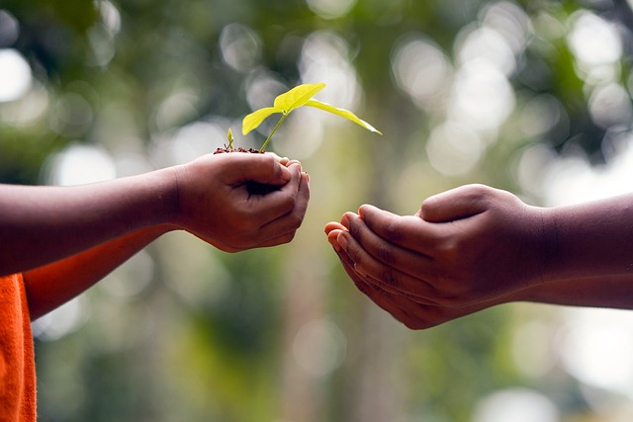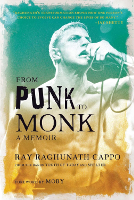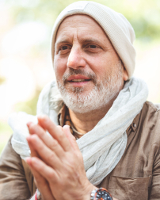
Image by Shameer Pk
Article Summary:
In 2015, I led a group of students on an annual pilgrimage to India, bringing my daughter on her second trip. This journey wasn't just a tour; it was a profound spiritual adventure that included visits to holy places, temples, and interactions with people deeply connected to Vedic teachings. Through these experiences, our lives were enriched with spiritual depth. The pilgrimage also brought meaningful conversations and insights, highlighting the contrasts between material pursuits and spiritual fulfillment. The journey reaffirmed the importance of giving back and maintaining deep connections to our cultural and spiritual roots.

It was 2015. I had been teaching yoga since 2003. I had been taking groups of students to India since 2007, visiting holy places, temples, and people. I’d gotten married. I’d raised my wife’s two little boys and had three children of my own with her.
We’d started a farm/retreat center in Upstate New York near the Berkshires to teach yoga asanas and bhakti and hold kirtans in a beautiful and natural setting. We did a lot of traveling with the kids, but India was not a tourist location for us. It was a pilgrimage.
Annual Pilgrimage to India
I was leading a big group of US and European students through holy places in northern India and bringing my ten-year-old daughter for her second trip. For a kid, it was an adventure to another world. We hustled to JFK Airport.
Thank God I got the aisle seat, I thought, thoroughly exhausted from the trek. I still have nine thousand miles to go before we reach Indira Gandhi International Airport.
My daughter was excited, looking around and playing with the in-flight TV screen. We were about to begin a sixteen-hour nonstop flight to New Delhi.
“Sit and chant four rounds of the Mahamantra on your mala before any of those movies go on,” I said sternly but with a smile. She politely obeyed. I didn’t look like a sadhu anymore. And controlling my five kids was as difficult as controlling the five senses, if not more so.
I had been taking the kids on my annual pilgrimages in rotation. To them, the holy places were normal. Puja, bathing in sacred rivers, temple worship, dancing in kirtan, offering food with love, serving others, bowing down, singing freely in the streets with their hands in the air, being free to cry and laugh out loud—this had all become normal for them. I prayed that it would last.
I was dressed in sweats and a T-shirt to make for a comfortable flight. I had been given the karmic gift to be able to fall asleep in my seat with my legs crossed like a mystic for nine hours straight on these late-night flights. Stretching, blinking, rested, I woke up perhaps over Istanbul, Moscow, or Warsaw. Who knew? Across the aisle, a young Indian man, probably thirty years my junior, was dressed in a US collegiate hoodie and sweatpants himself. He was wide awake with his reading light on.
Connection to the Vedic Teachings and Culture
I loved speaking to Indians to see where they were at, to see if they were still connected to the culture or had traded in that diamond for the broken glass of full-blown American consumerism. I was always amazed that many were still deeply connected, and how their Vedic teachings still held a directional pull in their life.
I was curious about the young man across from me.
“Excuse me, are you from India or America?” I said.
He smiled.
“The US,” he said softly. “I was raised in the US, but my parents are from India.” He pointed over to his sleeping older parents. “They came to America in the late 1970s.”
“Why did they come?” I asked, seeing that he seemed eager to engage in conversation with me.
“For a better financial future. They struggled in India and got the lottery to come,” he said referring to the immigrant lottery the US offers to those who want to become citizens.
“Were they professionals?”
“No, they did anything to raise me and my older brother,” he said with pride. “Literally anything. The US affords people like my parents upward mobility that wasn’t available for them back home.”
I nodded, as a parent appreciating what parents do for their children and the love that was behind it.
We were both leaning in to each other, happily engaged in conversation from both of our aisle seats.
“And what do you do for a living? Are you at the university?” I asked, looking at his outfit.
“I’ve just graduated and become a dentist.”
“That’s incredible. But I’m going to give a lot of credit to your parents!” I said coyly, looking at him as a parent myself.
He looked over to his sleeping parents. “Please give the credit to my parents. If it wasn’t for them and their lifelong sacrifice, I don’t know where I would be. I’m in great debt to them.”
“And your brother?” I asked. “What about him? What is his career path?”
He paused. “He too was a dentist.”
His face slightly changed from a cheerful smile to a more pensive smile with pursed lips, along with a nodding head but a slightly furrowed brow.
That made me pause. “And why do you say was a dentist? Did he give up that profession for another?” I think I was hitting a raw nerve.
He smiled again, but this smile wasn’t organic. He put on that smile as a teenager puts on a suit for a job interview, a suit he’s not comfortable in. His mind seemed filled with thought traffic.
Giving Up the Material World
“Yes. He did give it up.” He paused. “That’s why I’m going to India now. My brother has decided at this young age to take sannyasa. Do you know what that means?” he asked.
“Yes. I do,” I said with a sober face. “He’s giving up the world. He’s giving up his material life with formal vows.”
“In our particular tradition, when that God calling comes and we answer it, we break all ties with our loved ones.” He paused again.
“Not every tradition is like that in India,” I said. “I have been practicing bhakti yoga for thirty years, and my teacher is currently visiting his father now. The meaning of sannyasa in the Gita is that you give up the desire for sense gratification within the heart. So, it’s not necessarily where you are, or whom you’re associating with, but keeping our consciousness focused on ‘I’m not here to take from this world; I’m here to give back.’”
“My tradition is different,” he said. “When one takes sannyasa, the familial connections are totally over. We are all going to India to lovingly say goodbye to him.”
As a father, I paused. I furrowed my brow and nodded but needed more information.
“Are you hurt or . . . angry that he’s leaving?”
He ingested and inhaled my question. “At first I was,” he said, exhaling. “I was very angry. I felt abandoned. But this was all self-indulgent whining. In our culture”—he spoke firmly here, as if preaching—“we understand that the spiritual calling is the highest of all callings, and that everything and every person in this world is temporary and secondary to our original relationship with Narayana, or God. When we get that calling loud enough, we must answer it.”
He paused again. “My brother was a dentist, but he was always absorbed in spiritual matters, even as a child. He knew . . . we knew he had a higher calling.” He paused again. “It was only our selfishness that upset us. It was our loss. It hurt us all when he made that decision to leave. So, we dug deep and realized this is the most noble choice he could make, even though he didn’t fulfill our desires of what we wanted from him. We knew this would fulfill his deepest desires.”
He lifted his head. "You lived in some ashram, hmm?" and raised his eyebrows, waiting for an acknowledgment. I nodded.
“Then you know the joy of a regulated life, meditation, rising early, and inner work. His life will not be static and dreary. It will be ecstatic and inspired. This I know. This is why ’re doing this trip today. My parents and I want to support his choice, so we are going to say goodbye.”
He was speaking like a wise man, but I could tell his heart still hurt. “And now what will you do?” I asked.
Giving Back: A Very Ancient Path
“We will go and say goodbye and tell him how proud we are. I will do something different on my return. I will move back in with my parents, continue my dentistry, but take care of them now that they are older. My father suffers some ill health and cannot work.” He took a big inhale. “This is something I find heartbreaking about your culture”—he looked more deeply at me—“the parents give you everything when you are a vulnerable child, and you give nothing back to them when they are old and vulnerable.”
I took a deep breath and listened—and made a mental note to check in with my mom as soon as the plane landed in New Delhi.
“I’m going to care for them until they die. These are our parents!” He raised his voice. “They are not disposable. We take them, use them, and toss them out when they can no longer give. As a young man in America, I find it disheartening that people are so spiritually disconnected.”
“That’s beautiful,” I said. “I hope my children feel the same way. I’m sure your parents are proud . . . of both of you. ”
Being a Servant of God
“Hey bro, what is your name?” he asked
“Raghunath,” I said.
He smiled, as Raghunath is a beloved name in Hindu culture. “You know that’s a name for Lord Rama, right?”
“Yes, yes.” I head-bobbled and smiled. “Raghunath Das actually.
He appreciated my head bobble and my joking Indian accent.
“So, it’s not Raghunath—it’s the servant, or the das, of Raghunath.” “That’s right. My name means the servant of Raghunath, or the servant of God.”
“This is the problem nowadays in culture, and it’s ruining our planet,” he said casually and confidently. “People don’t want to serve God. They want to be God.” He paused, rearranged his sitting posture, and looked more deeply at me. “Wouldn’t you agree?”
“Yes. Desperately trying to be the center and not serve the center.”
Paying It Forward
The plane landed roughly, giving our bodies a shake, and a few of the passengers clapped. The Indira Gandhi Airport was like a glamourous mall compared to New Delhi’s uninspired and stodgy airport in 1988.
Taking my kids to India each year has been the greatest satisfaction I could ever have. Having them create a new normal and be acquainted with sacred people and sacred villages has been the most satisfying parenting experience.
How can I ever pay back all the people, teachers, and caregivers who have touched my heart with this spiritual magic? I cannot pay them back. I can only pay it forward.
“First stop, Rishikesh,” I told my daughter. “We’re going to the Ganges.”
Copyright 2024. All Rights Reserved.
Adapted with permission.
Article Recap:
This annual pilgrimage to India serves as a reminder of the profound spiritual depth and the joy found in yoga and embracing sacred traditions. It highlights the importance of giving back, maintaining cultural connections, and pursuing spiritual fulfillment over material gains. Through these journeys, we continue to discover and share the timeless wisdom and beauty of India's spiritual heritage.
Article Source:
BOOK: From Punk to Monk
From Punk to Monk: A Memoir
by Ray "Raghunath" Cappo.
 The heartfelt memoir of Ray Raghunath Cappo, a legendary hardcore punk musician-turned-monk—and pioneer of the straight-edge movement—told with warmth, candor, and humor. This heartfelt memoir chronicles Ray’s emotional and spiritual journey from punk to monk and beyond.
The heartfelt memoir of Ray Raghunath Cappo, a legendary hardcore punk musician-turned-monk—and pioneer of the straight-edge movement—told with warmth, candor, and humor. This heartfelt memoir chronicles Ray’s emotional and spiritual journey from punk to monk and beyond.
For more info and/or to order this hardcover book, click here. Also available as a Kindle edition.
About the Author
Visit the author's website at: Raghunath.yoga/



 As a teen in the 80s, Ray Cappo founded the hardcore punk band Youth of Today, which championed the principles of clean living, vegetarianism, and self-control. After experiencing a spiritual awakening in India, he formed a new band, Shelter, devoted to spreading a message of hope through spiritual connection. Ray currently leads yoga retreats, trainings, and kirtans at his Supersoul Farm retreat center in Upstate New York, as well as annual pilgrimages to India. He is the co-founder and co-host of
As a teen in the 80s, Ray Cappo founded the hardcore punk band Youth of Today, which championed the principles of clean living, vegetarianism, and self-control. After experiencing a spiritual awakening in India, he formed a new band, Shelter, devoted to spreading a message of hope through spiritual connection. Ray currently leads yoga retreats, trainings, and kirtans at his Supersoul Farm retreat center in Upstate New York, as well as annual pilgrimages to India. He is the co-founder and co-host of 























